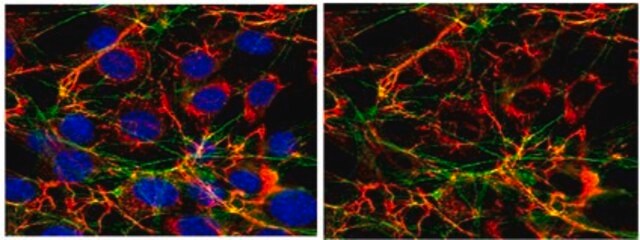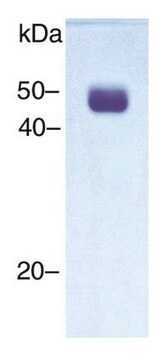AP182B
Donkey Anti-Rabbit IgG Antibody, biotin-SP conjugate, Species Adsorbed
Chemicon®, from donkey
Zaloguj sięWyświetlanie cen organizacyjnych i kontraktowych
About This Item
Kod UNSPSC:
12352203
eCl@ss:
32160702
NACRES:
NA.46
Polecane produkty
pochodzenie biologiczne
donkey
Poziom jakości
białko sprzężone
biotin conjugate
forma przeciwciała
affinity purified immunoglobulin
rodzaj przeciwciała
secondary antibodies
klon
polyclonal
reaktywność gatunkowa
rabbit
producent / nazwa handlowa
Chemicon®
metody
ELISA: suitable
western blot: suitable
Warunki transportu
wet ice
docelowa modyfikacja potranslacyjna
unmodified
Opis ogólny
Immunoglobulin G (IgG), is one of the most abundant proteins in human serum with normal levels between 8-17 mg/mL in adult blood. IgG is important for our defence against microorganisms and the molecules are produced by B lymphocytes as a part of our adaptive immune response. The IgG molecule has two separate functions; to bind to the pathogen that elicited the response and to recruit other cells and molecules to destroy the antigen. The variability of the IgG pool is generated by somatic recombination and the number of specificities in an individual at a given time point is estimated to be 1011 variants.
Specyficzność
Rabbit IgG
Zastosowanie
Donkey anti-Rabbit IgG Antibody, biotin-SP conjugate, Species Adsorbed detects level of Donkey Rabbit IgG & has been published & validated for use in ELISA & WB.
EIA: 1:50,000-1:100,000 Western blots using enzyme-conjugated streptavidin: 1:10,000-1:100,000. Immunohistochemistry: 1:500-1:5,000 Flow cytometry: 1:200-1:1,000 Fluorescence Immunohisto/cytochemistry: 1:200-1:1,1000 Optimal working dilutions must be determined by end user.
Research Category
Secondary & Control Antibodies
Secondary & Control Antibodies
Research Sub Category
Secondary Antibodies Adsorbed for Dual Labeling
Secondary Antibodies Adsorbed for Dual Labeling
Postać fizyczna
Lyophilized. Buffer = 0.01 M Sodium Phosphate, 0.15 M NaCl, pH 7.1 with 15 mg/mL BSA, and 0.1% sodium azide.
RECONSTITUTION:
Reconstitute with 500 μL of sterile distilled water.
RECONSTITUTION:
Reconstitute with 500 μL of sterile distilled water.
Przechowywanie i stabilność
Maintain lyophilized product at 2-8°C for up to 12 months. After reconstitution the product is stable for several weeks at 2-8°C as an undiluted liquid. For extended storage after reconstitution, add an equal volume of glycerol to make a final concentration of 50% glycerol followed by storage at -20°C in undiluted aliquots for up to 12 months. Please note the concentration of protein (and buffer salts) will decrease to one-half of the original after the addition of glycerol. Avoid repeated freeze/thaw cycles.
Informacje prawne
CHEMICON is a registered trademark of Merck KGaA, Darmstadt, Germany
Oświadczenie o zrzeczeniu się odpowiedzialności
Unless otherwise stated in our catalog or other company documentation accompanying the product(s), our products are intended for research use only and are not to be used for any other purpose, which includes but is not limited to, unauthorized commercial uses, in vitro diagnostic uses, ex vivo or in vivo therapeutic uses or any type of consumption or application to humans or animals.
This page may contain text that has been machine translated.
Nie możesz znaleźć właściwego produktu?
Wypróbuj nasz Narzędzie selektora produktów.
Zwroty wskazujące rodzaj zagrożenia
Zwroty wskazujące środki ostrożności
Klasyfikacja zagrożeń
Aquatic Chronic 3
Kod klasy składowania
11 - Combustible Solids
Klasa zagrożenia wodnego (WGK)
WGK 3
Certyfikaty analizy (CoA)
Poszukaj Certyfikaty analizy (CoA), wpisując numer partii/serii produktów. Numery serii i partii można znaleźć na etykiecie produktu po słowach „seria” lub „partia”.
Masz już ten produkt?
Dokumenty związane z niedawno zakupionymi produktami zostały zamieszczone w Bibliotece dokumentów.
Effects of spontaneous and forced running on activation of hypothalamic corticotropin-releasing hormone neurons in rats.
Shinya Yanagita,Seiichiro Amemiya,Satoko Suzuki,Ichiro Kita
Life Sciences null
Maternal exposure to carbon black nanoparticle increases collagen type VIII expression in the kidney of offspring.
Umezawa M, Kudo S, Yanagita S, Shinkai Y, Niki R, Oyabu T, Takeda K, Ihara T, Sugamata M.
The Journal of Toxicological Sciences null
Central administration of aminoprocalcitonin inhibits food intake and stimulates the hypothalamic-pituitary-adrenal axis in rats via the corticotrophin-releasing factor system.
E Tavares,R Maldonado,A Garcia-Martinez,F J Mi?ano
Journal of Neuroendocrinology null
An activation of parvocellular oxytocinergic neurons in the paraventricular nucleus in oxytocin-induced yawning and penile erection.
Ichiro Kita, Yasushi Yoshida, Seiji Nishino
Neuroscience Research null
Effects of maternal exposure to ultrafine carbon black on brain perivascular macrophages and surrounding astrocytes in offspring mice.
Onoda, A; Umezawa, M; Takeda, K; Ihara, T; Sugamata, M
Testing null
Nasz zespół naukowców ma doświadczenie we wszystkich obszarach badań, w tym w naukach przyrodniczych, materiałoznawstwie, syntezie chemicznej, chromatografii, analityce i wielu innych dziedzinach.
Skontaktuj się z zespołem ds. pomocy technicznej








